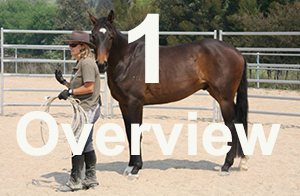
Round Pen - Overview
Using the round pen shouldn't mean chasing your horse around into a state of learned helplessness!
This course will show you how to teach your horse to learn while remaining calm and attentive - no chased or exhausted horses here!
Training Information
Suitable for: All horses
Videos in course: 6
Learn a lot about your horse's natural emotional level while teaching inside and outside turns and come-to-me.
Purpose
The purpose of this course is to teach you to use the round pen without chasing your horse.
The round pen has received a very bad reputation because some people have 'chased horses into exhaustion/submission' in the pen and labeled it learning or training.
Chasing a horse is NEVER conducive to learning, see the ISES Principles below, and the round pen needs to be used with care and purpose.
There is no doubt that it is much easier to induce fear in a horse than it is confidence - let's make your horse's round pen experience the very best possible.
The Basic Elements:
The SPOT on the horse that you want to move: The nose
The DIRECTION you want it to go: Towards you and away from you
The MOTIVATION for moving it: Pressure from your proximity to the horse and lariet
The REWARD given for the correct response: Release of pressure, relaxation of handler's posture, praise and allow the horse to rest
Notes:
The teaching of inside and outside turns is in now way essential to training your horse. I probably teach these lessons to less than 10% of horses I encounter and most of those are youngsters that have had limited education.
It is useful for such horses as the handler is not required to be in such close physical contact with the horse while he learns about pressure and release (human style!).
I do find the round pen a very useful place to train other things, such as learning to long-rein, haunch turns, transitions, flying changes and more.
Prerequisites
None
Timing
Teach one lesson at a time. I suggest teaching outside turns first as these are the easiest for the horse to learn. This lesson should only take a few minutes and should be conducted in trot.
Inside turns will take a little longer to teach so be sure to break it down for young horses.
Things to Remember:
- A frightened horse isn't learning anything.
- A chased horse is a frightened horse.
- A tired horse isn't learning anything.
- A sweaty horse is a tired horse.
- Young horses can only cope with short lessons - both chronologically and educationally young.
- These lessons are about teaching the horse to learn, not getting the horse exercised or fit.
- We are trying to engage the horse - almost the opposite of chase.
ISES Training Principles:
- Release the pressure immediately when the horse responds. Your physical presence and proximity to the horse is pressure. Clucking, or making other noise, is pressure, Walking behind the horse is pressure. The lariet is pressure, even just being held or banged against your side. ALL of these things must be released or stopped when the horse responds in the way that you are signalling him to do so.
- Use signals that the horse can differentiate. Teaching inside and outside turns could be confusing for the horse if your signals for each turn are not very different. Come-to-me must have a different and easily distinguishable cue of it's own.
- Train and initiate responses one at a time (shaping). When teaching come to me, for example, we need to signal the horse to inside turn so that he is facing us and then 'shape' this behaviour until the horse moves off the fence and then finally into the centre of the pen with us.
- Train habitual responses using consistency and repetition. Be consistent with the signal you give for each of the different turns. Every time you repeat the cue the horse should respond with the same turn. Be sure you decide beforehand which turn you want so that you are clear and consistent - release on the correct turn.
- Train only one response per signal. If your signal for come-to-me is a tapping on your hip then this should only signal come-to-me. Do not use the same signal for two things.
- Avoid fear during training. This is especially important in round pen training. It is very EASY to chase the horse and you need to be aware of this during the training.
- Train persistence of responses. The horse is learning useful responses. For example, the outside turns will be useful when you later teach the horse to long-rein and you need him to turn away from you. A slight shift in your position when long-reining will elicit an outside turn form your horse in these circumstances when the round pen lesson has been taught well.
- Check for relaxation. Is your horse in trot? If your horse is cantering then he is most unlikely to be relaxed and he will almost certainly be wasting precious energy. Check for signs of conflict such as kicking at you, pinning ears and head tossing - all good indications that the horse is not getting what you would like it to out of the lesson.
 ISES Training Principles Poster
ISES Training Principles PosterDownload your copy of the International Society for Equitation Science's (ISES) Training Principles Poster here.
 ISES Code of Conduct
ISES Code of ConductDownload your copy of the International Society for Equitation Science's Code of Conduct. Parts of this document are particularly applicable to those of you that compete or hold events.
